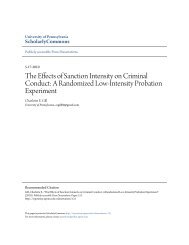A Sensible Model for Juvenile Justice - JDAI Helpdesk
A Sensible Model for Juvenile Justice - JDAI Helpdesk
A Sensible Model for Juvenile Justice - JDAI Helpdesk
Create successful ePaper yourself
Turn your PDF publications into a flip-book with our unique Google optimized e-Paper software.
A SENSIBLE MODEL FOR JUVENILE JUSTICE<br />
and Correlates). Started in 1986, the Causes and Correlates projects (Denver Youth Survey, Pittsburgh Youth<br />
Study, and Rochester Youth Development Study) used repeated contacts with age-specific cohorts of youth to<br />
reveal the complex empirical relationships between youth development and delinquency (Browning et al., 1999;<br />
Thornberry, Huizinga and Loeber, 2004).<br />
There are a number of existing practice frameworks in juvenile justice that could be used to build a new PYD<br />
approach <strong>for</strong> delinquency prevention, including the “competency development” component of the balanced<br />
and restorative justice model (Torbet and Thomas, 2005). Other compatible frameworks include strength-based<br />
approaches, asset building, wrap-around services, and various family-based services models, as well as the<br />
community assessment and intervention model known as “Communities That Care” (CTC), conceived by the<br />
Seattle Social Development Project (Hawkins et al., 2007).<br />
Applying PYD principles to juvenile justice interventions must be planned and coordinated, or the ef<strong>for</strong>t could<br />
dissolve into an array of disconnected programs. Without a theory-driven, goal-oriented strategy <strong>for</strong> constructing<br />
and operating interventions <strong>for</strong> youthful offenders, a PYD framework could easily become diluted and ineffective.<br />
Positive youth development is a broad concept. Which pieces are critical <strong>for</strong> young offenders? Should juvenile<br />
justice interventions focus on work, school or both? Should they include the arts, or is this a secondary concern<br />
<strong>for</strong> young offenders? If mentoring is an effective strategy to help youth build positive relationships with adults,<br />
do young offenders need a specialized <strong>for</strong>m of mentoring? These decisions must be based upon sound research<br />
findings.<br />
The first step in building a new PYD strategy <strong>for</strong> delinquency prevention is to reduce the multitude of PYD<br />
concepts to a workable set of core elements that would be appropriate in a juvenile justice context. Practitioners<br />
need a road map, or a bridge to join the wide array of PYD ideas with the operational realities of juvenile justice.<br />
Researchers have been calling <strong>for</strong> such a bridge <strong>for</strong> the past decade, but there are still no detailed models or<br />
frameworks available to practitioners (Barton, 2004; Bazemore and Terry, 1997; Schwartz, 2003).<br />
DO WE REALLY NEED<br />
A NEW MODEL?<br />
Some may ask, “but isn’t positive youth development basically what the juvenile justice system does now?”<br />
Un<strong>for</strong>tunately, the answer is often “no.” The public generally believes that prevention and early intervention are<br />
the principal functions of the juvenile justice system, but it is surprisingly rare to find jurisdictions that pursue<br />
these goals seriously. Especially in large cities, the first few offenses committed by a young person are usually<br />
ignored unless they involve violence, harm to victims, or other serious consequences. There are at least two<br />
reasons <strong>for</strong> this apparent policy failure. First, according to studies of self-reported delinquency, the vast majority<br />
of youth engage in at least some illegal behavior be<strong>for</strong>e adulthood. An estimated one in three juveniles will<br />
commit at least one serious act of property crime or violence be<strong>for</strong>e age 18 (Thornberry and Krohn, 2003:100-<br />
101). For this reason alone, the justice system refrains from taking action until a youth exhibits more persistent<br />
delinquency. Providing a <strong>for</strong>mal response to all instances of delinquency would be extremely expensive. Second,<br />
intervening through the auspices of the juvenile justice system involves significant risk. Contact with the justice<br />
SUMMER 2008 BEYOND THE TUNNEL PROBLEM | 7

















